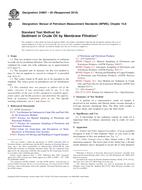Wir benötigen Ihre Einwilligung zur Verwendung der einzelnen Daten, damit Sie unter anderem Informationen zu Ihren Interessen einsehen können. Klicken Sie auf "OK", um Ihre Zustimmung zu erteilen.
ASTM D7691-11e1
Standard Test Method for Multielement Analysis of Crude Oils Using Inductively Coupled Plasma Atomic Emission Spectrometry (ICP-AES) (Includes all amendments And changes 6/17/2016).
Automatische name übersetzung:
Standard Test Method for Multielementanalyse von Rohölen Verwendung induktiv gekoppelte Plasma-Atom-Emissionsspektrometrie (ICP-AES)
NORM herausgegeben am 1.1.2011
Informationen über die Norm:
Bezeichnung normen: ASTM D7691-11e1
Anmerkung: UNGÜLTIG
Ausgabedatum normen: 1.1.2011
SKU: NS-38967
Zahl der Seiten: 9
Gewicht ca.: 27 g (0.06 Pfund)
Land: Amerikanische technische Norm
Kategorie: Technische Normen ASTM
Kategorie - ähnliche Normen:
Die Annotation des Normtextes ASTM D7691-11e1 :
Keywords:
crude oil, inductively coupled plasma-atomic emission spectrometry, iron, nickel, sulfur, vanadium, ICS Number Code 75.040 (Crude petroleum)
Ergänzende Informationen
| Significance and Use | ||||||||||||||||||||||||||||
|
Most often determined trace elements in crude oils are nickel and vanadium, which are usually the most abundant; however, as many as 45 elements in crude oils have been reported. Knowledge of trace elements in crude oil is important because they can have an adverse effect on petroleum refining and product quality. These effects can include catalyst poisoning in the refinery and excessive atmospheric emission in combustion of fuels. Trace element concentrations are also useful in correlating production from different wells and horizons in a field. Elements such as iron, arsenic, and lead are catalyst poisons. Vanadium compounds can cause refractory damage in furnaces, and sodium compounds have been found to cause superficial fusion on fire brick. Some organometallic compounds are volatile which can lead to the contamination of distillate fractions, and a reduction in their stability or malfunctions of equipment when they are combusted. The value of crude oil can be determined, in part, by the concentrations of nickel, vanadium, and iron. Inductively coupled plasma-atomic emission spectrometry (ICP-AES) is a widely used technique in the oil industry. Its advantages over traditional atomic absorption spectrometry (AAS) include greater sensitivity, freedom from molecular interferences, wide dynamic range, and multi-element capability. See Practice D7260. |
||||||||||||||||||||||||||||
| 1. Scope | ||||||||||||||||||||||||||||
|
1.1 This test method covers the determination of several elements (including iron, nickel, sulfur, and vanadium) occurring in crude oils. 1.2 For analysis of any element using wavelengths below 190 nm, a vacuum or inert gas optical path is required. 1.3 Analysis for elements such as arsenic, selenium, or sulfur in whole crude oil may be difficult by this test method due to the presence of their volatile compounds of these elements in crude oil; but this test method should work for resid samples. 1.4 Because of the particulates present in crude oil samples, if they do not dissolve in the organic solvents used or if they do not get aspirated in the nebulizer, low elemental values may result, particularly for iron and sodium. This can also occur if the elements are associated with water which can drop out of the solution when diluted with solvent. 1.4.1 An alternative in such cases is using Test Method D5708, Procedure B, which involves wet decomposition of the oil sample and measurement by ICP-AES for nickel, vanadium, and iron, or Test Method D5863, Procedure A, which also uses wet acid decomposition and determines vanadium, nickel, iron, and sodium using atomic absorption spectrometry. 1.4.2 From ASTM Interlaboratory Crosscheck Programs (ILCP) on crude oils data available so far, it is not clear that organic solvent dilution techniques would necessarily give lower results than those obtained using acid decomposition techniques. 1.4.3 It is also possible that, particularly in the case of silicon, low results may be obtained irrespective of whether organic dilution or acid decomposition is utilized. Silicones are present as oil field additives and can be lost in ashing. Silicates should be retained but unless hydrofluoric acid or alkali fusion is used for sample dissolution, they may not be accounted for. 1.5 This test method uses oil-soluble metals for calibration and does not purport to quantitatively determine insoluble particulates. Analytical results are particle size dependent and low results may be obtained for particles larger than a few micrometers. 1.6 The precision in Section 18 defines the concentration ranges covered in the interlaboratory study. However, lower and particularly higher concentrations can be determined by this test method. The low concentration limits are dependent on the sensitivity of the ICP instrument and the dilution factor used. The high concentration limits are determined by the product of the maximum concentration defined by the calibration curve and the sample dilution factor. 1.7 Elements present at concentrations above the upper limit of the calibration curves can be determined with additional appropriate dilutions and with no degradation of precision. 1.8 As a generality based on this interlaboratory study (see 18.1), the trace elements identifiable in crude oils can be divided into three categories: 1.8.1 Element levels that are too low for valid detection by ICP-AES and hence, cannot be determined: aluminum, barium, lead, magnesium, manganese, and silicon. 1.8.2 Elements that are just at the detection levels of the ICP-AES method and hence, cannot be determined with a great deal of confidence: boron, calcium, chromium, copper, molybdenum, phosphorus, potassium, sodium, and zinc. Perhaps the determination of these elements can be considered as semi-quantitative. 1.8.3 Elements that are at higher levels of concentration and can be determined with good precision: iron, nickel, sulfur, and vanadium. |
||||||||||||||||||||||||||||
| 2. Referenced Documents | ||||||||||||||||||||||||||||
|
Ähnliche Normen:
Historisch
1.7.2010
Historisch
1.6.2011
Historisch
1.5.2011
Historisch
1.11.2012
Historisch
1.5.2010
Historisch
1.12.2012
Empfehlungen:
EEviZak – alle Gesetze einschließlich ihrer Evidenz in einer Stelle
Bereitstellung von aktuellen Informationen über legislative Vorschriften in der Sammlung der Gesetze bis zum Jahr 1945.
Aktualisierung 2x pro Monat!
Brauchen Sie mehr Informationen? Sehen Sie sich diese Seite an.



 ASTM D4310-10
ASTM D4310-10 ASTM D4377-00(2011)..
ASTM D4377-00(2011).. ASTM D4489-95(2011)..
ASTM D4489-95(2011).. ASTM D473-07(2012)..
ASTM D473-07(2012).. ASTM D4807-05(2010)..
ASTM D4807-05(2010).. ASTM D4928-12
ASTM D4928-12
 Cookies
Cookies
